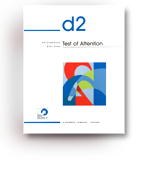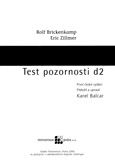 |

d2 Test of Attention
Göttingen, Germany: Hogrefe & Huber, 1998
............................................
Tower of London - Drexel University (TOL DX)
Chicago, IL: Multi-Health Systems, 2001
[more]
|
 |
|
 |
 |
 |
d2
Test of Attention

Rolf Brickenkamp & Eric Zillmer
Göttingen, Germany: Hogrefe & Huber, 1998
|

 |

Cover: Czech translation.
.......................................

30 Amberwood Parkway
Ashland, OH 44805
USA
T: (800) 228-3749
F: (419) 281-6883
Rohnsweg 25
37085 Göttingen
Germany
T: +49 551 99 50
F: +49 551 999 50 425
custserv@hogrefe.com
www.hogrefe.com
|
The d2 Test is a timed test of selective attention and is a standardized refinement of a visual cancellation test (Brickenkamp & Zillmer, 1998). The English version has been translated into Czeck and the German version is the most frequently used test of attention in Europe. In response to the discrimination of similar visual stimuli, the test measures processing speed, rule compliance, and quality of performance, allowing estimation of individual attention and concentration performance. The test was originally developed in 1962 in Germany and Switzerland as an assessment tool for driving efficiency. Subjects who fail the d2 task tend to have difficulty concentrating, including difficulty in warding off distractions (Zillmer & Kennedy, 1999a, 1999b).
The test items consist of the letters d and p with one to four dashes, arranged either individually or in pairs above and below the letter. The subject must scan across each line to identify and cross out each d with two dashes. In the manual these items (correct hits) are called "relevant items." All other combinations of letters and lines are considered "irrelevant," because they should not be crossed out. The one-page d2 Test form provides sections for recording identifying data and test scores, and provides a practice sample. On the reverse side is the standardized test, consisting of 14 lines, each with 47 characters, for a total of 658 items. The subject is allowed 20 seconds per line. The test can be purchase at from Hogrefe & Huber.
|
|